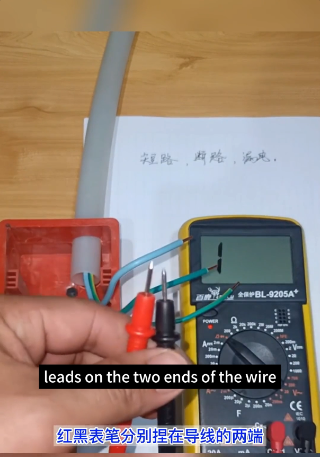short circuits, open circuits, and leakage currents
 In electrical circuits, short circuits, open circuits, and leakage currents are three distinct types of faults, differing significantly in their principles, manifestations, and hazards. Below is a detailed explanation of how to distinguish these three scenarios:
In electrical circuits, short circuits, open circuits, and leakage currents are three distinct types of faults, differing significantly in their principles, manifestations, and hazards. Below is a detailed explanation of how to distinguish these three scenarios:
*1. Short Circuit**
**Definition**:
A short circuit occurs when two electrical terminals that should not be directly connected are accidentally joined (e.g., due to damaged wire insulation or component failure), causing current to bypass the load (such as light bulbs or resistors) and flow through the shorted path instead.
**Key Characteristics**:
1. **Extremely High Current**: Due to minimal loop resistance (close to that of the wire itself), the current surges dramatically according to Ohm's Law (\(I = \frac{U}{R}\)), potentially reaching tens or hundreds of times the normal current.
2. **Rapid Temperature Increase**: The high current causes wires or components to overheat rapidly, risking fire or equipment damage.
3. **Protective Device Activation**: Fuses blow quickly, and circuit breakers trip, immediately cutting off the power supply.
**Common Scenarios**:
- Exposed wires inside a household appliance's plug contacting the metal casing.
- Aging or damaged wires causing direct contact between live and neutral wires.
- Accidental contact between component leads on a circuit board, leading to soldering point short circuits.
**Detection Methods**:
- Use a multimeter's resistance mode to measure the resistance between two points in the circuit; a reading close to zero indicates a potential short circuit.
- If the protective device trips immediately after powering on, a short circuit is likely the cause.
*2. Open Circuit**
**Definition**:
Also known as an open circuit, an open circuit refers to a break in the circuit where the current cannot form a complete loop, leaving the circuit in a disconnected state.
**Key Characteristics**:
1. **No Current Flow**: The current in the entire circuit or part of the branch is zero, and the load cannot operate (e.g., a light bulb does not light, or a motor does not run).
2. **Voltage Anomaly**: The supply voltage may be measured across the break point (e.g., when the live and neutral wires are disconnected, the live wire side of the break point remains energized).
3. **Protective Device Inaction**: Typically, fuses do not blow, and circuit breakers do not trip (unless accompanied by other faults).
**Common Scenarios**:
- Loose, oxidized, or broken wire connections.
- Poor contact or damage to switches (e.g., burnt contacts).
- Detached leads or internal fractures in components (such as resistors or capacitors).
**Detection Methods**:
- Use a multimeter's voltage mode to measure voltages at various points in the circuit; if the voltage between two points equals the supply voltage and the load is not working, a break may exist there.
- Use the resistance mode to check the circuit's continuity; an infinite resistance indicates an open circuit.
*3. Leakage Current**
**Definition**:
Leakage current refers to the abnormal flow of current from the normal circuit path to unintended pathways (such as ground or the human body) due to degraded insulation, creating an abnormal current loop.
**Key Characteristics**:
1. **Small but Sustained Current**: Leakage currents are typically smaller than short-circuit currents (ranging from milliamps to hundreds of milliamps) but persist continuously.
2. **Possible Protective Device Activation**: If the leakage current exceeds the threshold of a residual current device (RCD) (e.g., 30mA), it will trigger a trip.
3. **Safety Hazards**: May cause electric shock risks, energized equipment casings, or power loss issues.
**Common Scenarios**:
- Moisture or aging of electrical insulation (e.g., a washing machine or water heater casing becoming energized).
- Damaged wires contacting metal pipes or walls (ground leakage).
- Component breakdown on circuit boards causing current to flow to the ground terminal.
**Detection Methods**:
- Use a leakage tester or megohmmeter to measure the insulation resistance of the circuit; a value below the standard (e.g., less than 0.5MΩ) indicates potential leakage.
- Observe if the RCD trips frequently (in the absence of short circuits or overloads).
*4. Comparison Table**
| Characteristic | Short Circuit | Open Circuit | Leakage Current |
| Current Path | Bypasses load, direct flow | Path interrupted, no loop | Partial flow to unintended paths |
| Current Magnitude | Extremely high (far exceeds rating) | Nearly zero | Small (milliamperes) |
| Protective Devices | Fuse blows/circuit breaker trips | No action (usually) | RCD trips |
| Typical Symptoms | Smoking, overheating, tripping | Device non-operation | Energized casing, abnormal power bills |
| Risk Level | High (fire hazard) | Medium (device inoperable) | High (electric shock, leakage fire) |
*5. Safety Recommendations**
1. **Prevent Short Circuits**: Regularly inspect wire insulation, avoid overloading circuits, and use certified electrical appliances.
2. **Troubleshoot Open Circuits**: Focus on checking connections, switches, and component soldering points to ensure secure links.
3. **Address Leakage Currents**: Install RCDs, regularly test insulation, and use waterproof equipment in damp environments.
In case of electrical faults, it is recommended to power off the circuit and consult a professional electrician for inspection to avoid risks from DIY operations.


